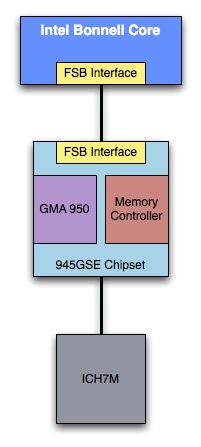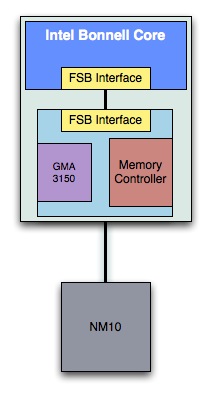Intel Unveils Moorestown and the Atom Z600, The Fastest Smartphone Platform?
by Anand Lal Shimpi on May 4, 2010 11:54 PM EST- Posted in
- Smartphones
- Intel
- Atom
- Mobile
- SoCs
The World Changes, MIDs Ahead of Their Time
Silverthorne lacked integration, which wasn’t a problem for MIDs and netbooks, but it kept the chip out of smartphones. Between 2004 and Atom’s introduction in 2008 the iPhone happened. All of the sudden the clunky MIDs we were reluctantly waiting for stopped being interesting. What we wanted were more iPhones, and iPhone clones. Then came Android and the rest is history. While Atom had tremendous success in netbooks, Intel’s decision to pursue a discrete route first kept it out of smartphones.
Luckily, next on the list after the first Atom was a more integrated one with the goal of dropping power consumption. We saw this with Pine Trail, the netbook Atom that brought the memory controller and GPU on-die. Performance didn’t improve because unlike most integrated memory controllers, this one still connected to the CPU via a FSB.
Intel Atom "Diamondville" Platform 2008 |
Intel Atom "Pine Trail" Platform 2009-2010 |
 |
 |
Pine Trail still has all of the bells and whistles of a PC platform however. Take the PCI bus for example. Every 12 microseconds it wakes up and polls every IO on the platform. That kills idle battery life, especially when you’ve got a tiny smartphone battery. Pine Trail is useless for smartphones, and that’s where Moorestown comes in.
If you thought this was the netbook Atom squeezed into a smartphone, you’re very wrong. It’s got a completely different memory controller, a true smartphone GPU (the same core, but clocked higher than what’s in the iPhone 3GS) and a ton of power optimizations that just don’t exist in the netbook version. The chipset is also very different. The PCI bus is gone as is anything that could ruin power consumption. Intel did a lot of optimization and a lot of cutting here. What resulted is something that looks a lot like a smartphone hardware platform and nothing like what we’re used to seeing from Intel.
This is Moorestown.










67 Comments
View All Comments
strikeback03 - Wednesday, May 5, 2010 - link
No, I think he is asking for Windows 7, not Windows Phone 7. WHich I can see being useful on a tablet, but not at all on a phone. It would take so much effort to turn the standard version of Windows 7 into something usable on a phone that I would imagine if x86 does take off in smartphones Microsoft would be better off just making a completely new OS that can run windows programs.logdrum - Saturday, November 20, 2010 - link
There are Moorsetown tablets running Windows 7, As long as the chipset has a PCI bus Windows 7 heck even Windows 2003 server shuld install. The smart phone do not have a PCI bus therefore you cannot install Windows 7logdrum - Saturday, November 20, 2010 - link
It is not a limitation of x86. Windows needs a PCI bus to install and run. There is no PCI bus in Intel embedded systems or ARM for that matter. Having said that you can install VMware on the Linux OS and install Windows as a Virtual Machine. Some people even say hacking the firmware of the embedded hardware to fake a PCI bus so Windows would install. It could be done. Take one of those WindRiver classes on fastboot and kboot and maybe you could make it happen.logdrum - Saturday, November 20, 2010 - link
I am talking here purely x86 Windows, the one on desktops and netbooks and even tablets. Tablets have a PCI bus usually. The phone factor of Moorsetown does not have,jaydee - Wednesday, May 5, 2010 - link
Dual-boot Windows 7 and Android on a 10" tablet. Please?arnavvdesai - Wednesday, May 5, 2010 - link
I think getting 3 out of 5 will be very hard for Intel, especially Apple because that company has sunk so much of its own money into chip IP. Apple is not content with just getting the best hardware out there in ARM world but wants to actually design the chip around its own OS so I dont see them using the Atom series.Intel says Win7CE & Win8CE are both out so that leaves them in a bad place. However, Microsoft is working on a micro OS kernel inside its labs called Menlo( I am not sure about the name) which Intel could try and effectively market to. Basically in Menlo Microsoft is trying to shrink NT to super small size and footrpint.
DanNeely - Wednesday, May 5, 2010 - link
Intel offered the ability to create custom atom SOC's via TSMC fabs about a year ago. It was withdrawn due to lack of interest; but if apple was interested I'm certain they'd make it available again.aguilpa1 - Wednesday, May 5, 2010 - link
People will forgive lots of things if the thing just looks HOT and works as it should. It has been a long time since I have been wowed by any of the new smartphone devices, including the iphone. It is sleek and well built but a little to chunky and roundish for my taste. However they get the style look down.geniekid - Wednesday, May 5, 2010 - link
Would it be possible to leverage Moorestown in a way that yields 2x the battery life with the same performance as today's top end smartphones? Most 3GS/N1 users today would rather have more battery life than HD playback ability. Unfortunately, as I think about it, I believe that the battery sucking features of the phone are the peripheral devices - wifi/3g radio, camera, display, things which are outside the scope of Moorestown.Mike1111 - Wednesday, May 5, 2010 - link
If the Z600 only support 1024x600 or higher, how come the Aava reference platform has 800x480?And even though I think the performance is very good, Z600 is still too big to compete in the Smartphone market (3-4 chips instead of 1)? I don't see how that could work with something as small as the iPhone 4th-gen's mainboard, which is incredible tiny.
Also Intel talks about combining Lincroft and Langwell into one chip, but no official word on memory in the same package? Only Anand speculates about it.
But if they Intel can integrate at least these three chips into one package with Medfield and offer some additional improvements plus @32nm, and have actual Medfield smartphones on the shelves by the holiday season 2011, Intel can finally start to compete in the smartphone market.